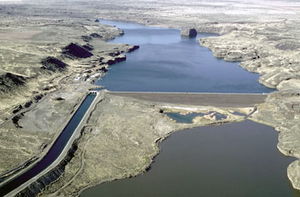Pinto Dam
| Pinto Dam (Billy Clapp Lake) |
|||
|---|---|---|---|
|
|||
|
|
|||
| Coordinates | 47 ° 26 '50 " N , 119 ° 15' 0" W | ||
| Data on the structure | |||
| Construction time: | 1946-1948 | ||
| Height of the barrier structure : | 40 m | ||
| Crown length: | 579 m | ||
| Base width: | 180 m | ||
| Operator: | United States Bureau of Reclamation | ||
| Data on the reservoir | |||
| Water surface | 3,940 km² | ||
| Maximum depth | 91 m | ||
| Total storage space : | 26,100,000 m³ | ||
| Catchment area | 490 km² | ||
The Pinto Dam is a dam in Grant County in the US state of Washington .
The dam was built as part of a project by the United States Bureau of Reclamation ; it was completed between 1946 and 1948 as part of the huge Columbia Basin Project and is used to store water for irrigation, flood control and power generation. The Pinto Dam is an earth dam, 40 m high and 579 m long at the top. It stores the water away from a river.
The six-mile (9.6 km) long, crescent-shaped reservoir, Billy Clapp Lake, was originally called Long Lake Reservoir, but was renamed after one of the project's sponsors, an Ephrata lawyer . You can fish all year round on the lake. There are American perch , crappies , rainbow trout and glass eyes perch caught. The Stratford Wildlife Recreation Area borders the east shore of Billy Clapp Lake and provides shelter for migrating waterfowl. Another fairly large lake, Brook Lake, is located below the dam.
Columbia Basin Project
Pinto Dam and Billy Clapp Lake are part of the Main Canal (1951) within the Columbia Bsin Project. The canal is eight miles long and runs from Banks Lake to Billy Clapp Lake. From the outlet of Billy Clap Lake, the lower reaches of the Main Canal runs westwards and branches off near Adco on Washington State Route 28 into the East Low and West Canal. The total length of the canals is 34 km including 8.58 kilometers within Long Lake. By building Long Lake Dam, later renamed Pinto Dam, the Bureau of Reclamation used the river terrace to save costs.
Billy Clapp Lake
The Billy Clapp Lake created by the Pinto Dam lies along its entire length within the Long Lake Coulee. The river terrace (engl. Coulee ) is the result of the Missoula floods . The reservoir is 9.6 km long and about 800 m wide with a maximum depth of 91 meters. Before the reservoir was created, the basin it fills today contained five smaller lakes (Long Lake, Coffee Pot Lake, Pot Lake, Cold Spring Lake, and July Lake).
Pinto Dam
The Pinto Dam is a zoned dam wall that has been filled in with earth and rocks; it is about 580 m long at the crown and a total of 40 m high. An unregulated overflow channel runs on the left side of the dam through a channel carved into the rock. The Billy Clapp Head Works (dt. Front stabilizer ) has radial gates to control the discharge in the lower reaches of the Main Canal.
Individual evidence
- ↑ a b United States Bureau of Reclamation: Pinto Dam: General . April 30, 2009. Retrieved January 23, 2015.
- ^ A b c The Story of the Columbia Basin Project . United States Government Printing Office, Washington DC 1964, p. 59 (Retrieved January 23, 2015).
- ^ A b Washington State Department of Fish & Wildlife: Billy Clapp Lake . Retrieved January 23, 2015.
- ↑ a b United States Bureau of Reclamation: Pinto Dam: Hydraulics and Hydrology . April 30, 2009. Retrieved January 23, 2015.
- ↑ United States Bureau of Reclamation: Columbia Basin Project . December 4, 2013. Archived from the original on February 15, 2015. Retrieved on January 23, 2015.
- ↑ Washington Department of Fish & Wildlife: Billy Clapp Lake Unit . Retrieved January 23, 2015.
- ^ Cassandra Tate: Grand Coulee Dam . March 10, 2005. Retrieved January 23, 2015.
- ^ A b c Draft Environmental Statement, Columbia Basin Project, Washington; Columbia Basin Project, Ephrata, Washington; Department of the Interior, (INT DES-75-3), Bureau of Reclamation, Department of the Interior; Washington, DC; 1975
- ^ The Columbia Basin Project; Wm. Joe Simonds; Bureau of Reclamation History Program; Denver, Colorado; Research on Historic Reclamation Projects; 1998

